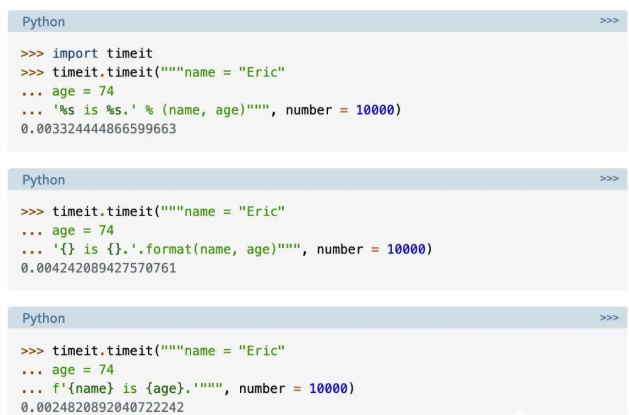
学过Python的朋友应该都知道 f-strings 是用来非常方便的格式化输出的,觉得它的使用方法无外乎就是 print(f'value = { value }',其实,f-strings 远超你的预期,今天来梳理一下它还能做那些很酷的事情。
1、懒得再敲一遍变量名
str_value = "hello,python coders" print(f"{ str_value = }") # str_value = 'hello,python coders'
2、直接改变输出结果
num_value = 123 print(f"{num_value % 2 = }") # num_value % 2 = 1
3、直接格式化日期
import datetime
today = datetime.date.today()
print(f"{today: %Y%m%d}") # 20211019 print(f"{today =: %Y%m%d}") # today = 20211019
4、2/8/16 进制输出真的太简单
>>> a = 42 >>> f"{a:b}" # 2进制 '101010' >>> f"{a:o}" # 8进制 '52' >>> f"{a:x}" # 16进制,小写字母 '2a' >>> f"{a:X}" # 16进制,大写字母 '2A' >>> f"{a:c}" # ascii 码 '*'
5、格式化浮点数
>>> num_value = 123.456 >>> f'{num_value = :.2f}' #保留 2 位小数 'num_value = 123.46' >>> nested_format = ".2f" #可以作为变量 >>> print(f'{num_value:{nested_format}}') 123.46
6、字符串对齐,so easy!
>>> x = 'test' >>> f'{x:>10}' # 右对齐,左边补空格 ' test' >>> f'{x:*<10}' # 左对齐,右边补* 'test******' >>> f'{x:=^10}' # 居中,左右补= '===test===' >>> x, n = 'test', 10 >>> f'{x:~^{n}}' # 可以传入变量 n '~~~test~~~' >>>
7、使用 !s,!r
>>> x = '中' >>> f"{x!s}" # 相当于 str(x) '中' >>> f"{x!r}" # 相当于 repr(x) "'中'"
8、自定义格式
class MyClass: def __format__(self, format_spec) -> str: print(f'MyClass __format__ called with {format_spec=!r}')
return "MyClass()" print(f'{MyClass():bala bala %%MYFORMAT%%}')
输出如下:
MyClass __format__ called with format_spec='bala bala %%MYFORMAT%%' MyClass()
最后
Python 的 f-string 非常灵活优雅,同时还是效率最高的字符串拼接方式:

以后关于字符串的格式化,就 f-string 了。
以上就是“Python的f-strings作用远超你的预期”的详细内容,想要了解更多Python教程欢迎持续关注编程学习网
扫码二维码 获取免费视频学习资料

- 本文固定链接: http://www.phpxs.com/post/9983/
- 转载请注明:转载必须在正文中标注并保留原文链接
- 扫码: 扫上方二维码获取免费视频资料
查 看2022高级编程视频教程免费获取

